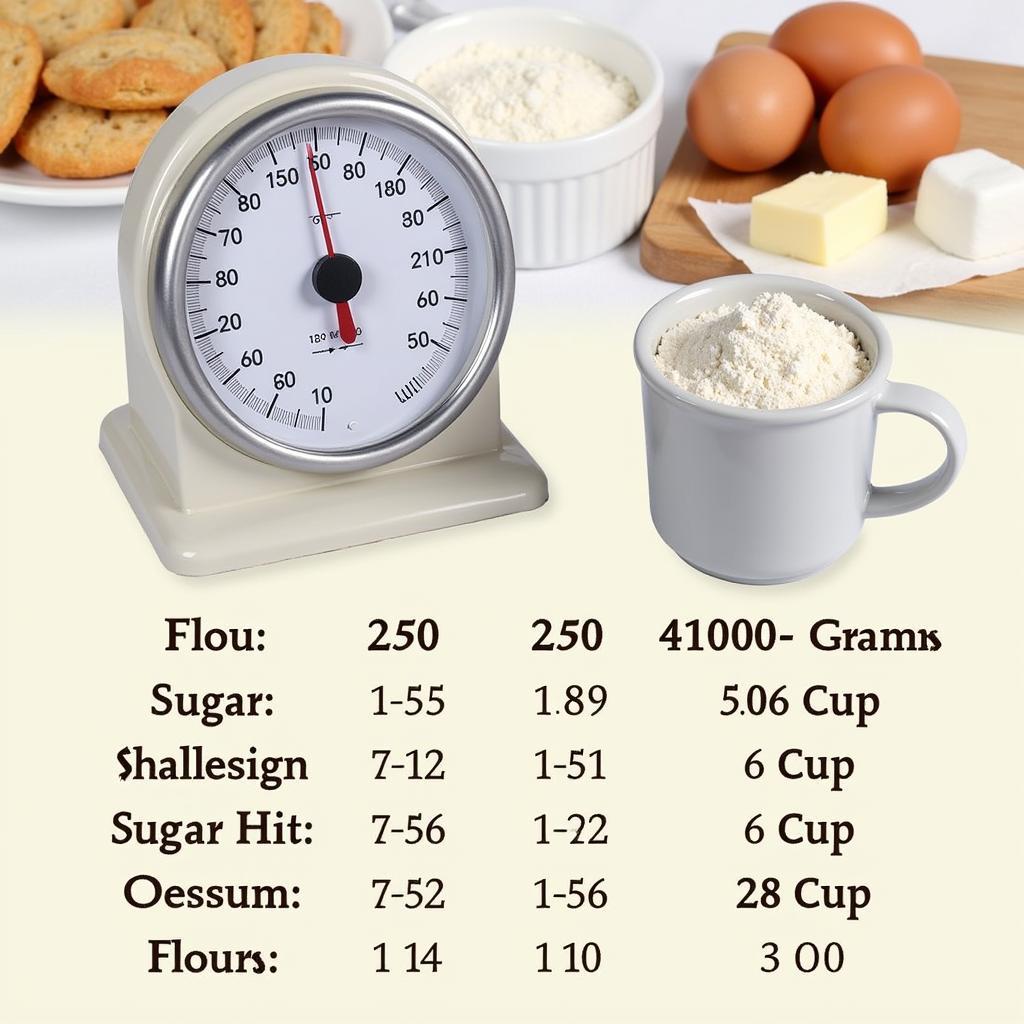Understanding g to cups conversion is crucial for anyone who enjoys cooking or baking. This conversion helps ensure accurate measurements, leading to consistent and delicious results in the kitchen. Whether you’re following a complex recipe or simply experimenting with new flavors, mastering this conversion is an essential skill.
Decoding G to Cups Conversion
Converting grams (g) to cups isn’t a straightforward one-size-fits-all process. Unlike converting within the same unit system (like milliliters to liters), converting between weight (grams) and volume (cups) depends on the ingredient’s density. For example, 100g of flour will occupy a different volume than 100g of sugar. This is because flour is less dense than sugar. Therefore, the key to accurate conversion lies in understanding the specific ingredient you’re working with.
Why is G to Cups Conversion Important?
Accurate measurements are the cornerstone of successful cooking and baking. Using the correct amount of each ingredient ensures that the recipe turns out as intended, achieving the desired texture, flavor, and consistency. Imagine adding too much baking powder to your cake batter – it might rise too quickly and then collapse. Or, if you don’t use enough flour, your cookies could spread too thin and become crispy. G to cups conversion helps you avoid these pitfalls, guaranteeing culinary success every time. Similar to 70 ml to cups, understanding the relationship between these units of measurement is crucial.
Many recipes, especially those originating from different parts of the world, use varying units of measurement. While some might list ingredients in cups, others might use grams. Being able to confidently convert between these units allows you to access a wider range of recipes and expand your culinary horizons. You’ll no longer be limited by the units used in a recipe. For instance, you could easily make a French pastry recipe that uses grams even if you’re more familiar with cups.
Common Ingredients and Their Conversions
While there are online calculators and conversion charts available, it’s helpful to familiarize yourself with the approximate conversions for common ingredients:
- Flour (all-purpose): 1 cup ≈ 125g
- Sugar (granulated): 1 cup ≈ 200g
- Butter: 1 cup ≈ 227g
- Water: 1 cup ≈ 240g
Remember, these are just approximations. For the most accurate conversions, always refer to a specific conversion chart or calculator for the ingredient you are using. Knowing the conversion for common ingredients like cream cheese oz to cups is also helpful.
Using Conversion Tools
Various online tools and apps can help you quickly and accurately convert grams to cups. These tools often include a wide range of ingredients, making them a convenient resource in the kitchen. Simply input the number of grams and select the ingredient, and the tool will calculate the equivalent volume in cups. Some tools even allow you to convert between other units, such as ounces and milliliters. These tools eliminate the need for manual calculations, saving you time and effort.
Tips for Accurate Conversion
- Use a kitchen scale: A kitchen scale is the most accurate way to measure ingredients by weight. This ensures precision and consistency in your recipes. This is much more reliable than using measuring cups for dry ingredients, which can be affected by how tightly the ingredient is packed.
- Level off dry ingredients: When measuring dry ingredients with a measuring cup, use a straight edge (like a knife) to level off the top. This ensures you’re not using too much or too little of the ingredient. This is especially important for ingredients like flour and sugar, where even slight variations can impact the final product. Just like understanding the conversion of 155g to cups, accuracy is key.
- Refer to reliable sources: Use reputable websites or cookbooks for conversion charts. This ensures you’re using accurate information and avoids potential errors in your recipes.
G to Cups Conversion in Everyday Cooking
Understanding g to cups conversion goes beyond baking. It’s also helpful for other culinary endeavors, such as making sauces, soups, and even cocktails. For example, if a recipe calls for a certain amount of flour in grams to thicken a sauce, you can easily convert it to cups if that’s how you prefer to measure.
Expert Insight: “Mastering g to cups conversion is like learning a new language in the kitchen,” says renowned Chef Nguyen Manh Hung, “It opens up a world of culinary possibilities, allowing you to explore diverse recipes and techniques with confidence. It’s the foundation for precision and consistency, ensuring your dishes turn out perfectly every time.”
Conclusion
G to cups conversion is a valuable skill for any home cook or baker. By understanding the principles of conversion and using the right tools, you can achieve accurate measurements and consistent results in your recipes. Embrace the power of precise measurement and elevate your cooking to new heights. Remember, consistent deliciousness begins with accurate measurements!
Expert Insight: “Don’t be intimidated by g to cups conversion,” adds Culinary Instructor Pham Thu Trang, “It might seem complex at first, but with practice and the right resources, it becomes second nature. Start with common ingredients and gradually expand your knowledge. Soon, you’ll be converting with ease and creating culinary masterpieces.”
For those curious about converting volume to milliliters, check out 5 cups into ml. And for a comprehensive guide on converting cups to milliliters, visit cups to milliliters.
When you need assistance, please contact us at Phone Number: 0372999996, Email: bong.da@gmail.com Or visit our address: 236 Cau Giay, Hanoi. We have a 24/7 customer service team.

